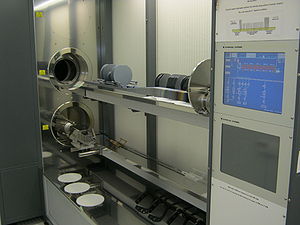Specific Process Knowledge/Thin film deposition/Furnace LPCVD PolySilicon: Difference between revisions
| Line 25: | Line 25: | ||
*[[Specific_Process_Knowledge/Thin_film_deposition/Deposition_of_polysilicon/Deposition_of_polysilicon_using_LPCVD/Standard_recipes,_QC_limits_and_results_for_the_4%22_polysilicon_furnace|Deposition of polysilicon using the 4" polysilicon furnace]] | *[[Specific_Process_Knowledge/Thin_film_deposition/Deposition_of_polysilicon/Deposition_of_polysilicon_using_LPCVD/Standard_recipes,_QC_limits_and_results_for_the_4%22_polysilicon_furnace|Deposition of polysilicon using the 4" polysilicon furnace]] | ||
*[[ | *[[/Boron doped poly-Si and a-Si |Boron doped poly-Si and a-Si by using 4" polysilicon furnace]] | ||
*[[Specific_Process_Knowledge/Thin_film_deposition/Deposition_of_polysilicon/Deposition_of_polysilicon_using_LPCVD/Standard_recipes,_QC_limits_and_results_for_the_6%22_polysilicon_furnace|Deposition of polysilicon using the 6" polysilicon furnace]] | *[[Specific_Process_Knowledge/Thin_film_deposition/Deposition_of_polysilicon/Deposition_of_polysilicon_using_LPCVD/Standard_recipes,_QC_limits_and_results_for_the_6%22_polysilicon_furnace|Deposition of polysilicon using the 6" polysilicon furnace]] | ||
| Line 33: | Line 33: | ||
*[[Specific Process Knowledge/Thin film deposition/Deposition of polysilicon/Deposition of polysilicon using LPCVD|Deposition of polysilicon using LPCVD]] | *[[Specific Process Knowledge/Thin film deposition/Deposition of polysilicon/Deposition of polysilicon using LPCVD|Deposition of polysilicon using LPCVD]] | ||
hide text --> | hide text --> | ||
==Overview of the performance of the LPCVD polysilicon processes and some process related parameters== | ==Overview of the performance of the LPCVD polysilicon processes and some process related parameters== | ||
Revision as of 13:06, 2 November 2015
Feedback to this page: click here
Deposition of polysilicon using LPCVD


Danchip has two furnaces for deposition of LPCVD (Low Chemical Vapour Deposition) polysilicon: A 6" furnace (installed in 2011) for deposition of standard polySi, amorphous polySi and boron doped polySi on 100 mm or 150 mm wafers and a 4" furnace (installed in 1995) for deposition of standard polySi, amorphous polySi, boron- and phosphorous doped polySi on 100 mm wafers. In LabManager the two furnaces are named "Furnace: LPCVD Poly-Si (4") (B4)" and "Furnace: LPCVD Poly-Si (6") (E2)", respectively. Both furnaces are Tempress horizontal furnaces.
The LPCVD polysilicon deposition is a batch process, where polySi is deposited on a batch of 25 or 50 wafers (6" polySi furnace) or 30 wafers (4" polySi furnace). The polySi has a good step coverage, and especially for standard polySi the film thickness is very uniform over the wafers.
The reactive gas is silane (SiH4). The dopant for boron doped polySi is BCl3 (6" polySi furnace) or B2H6 (4" polySi furnace), and for phosphorous doped polySi the dopant is PH3. For standard and doped polysilion the deposition takes place at a temperature of 600 oC - 620 oC and a pressure of 200-250 mTorr. For amorphous polysilicon the deposition temperatures and thus the deposition rate are lower. For phosphorus doped polySi the deposition rate is approximately ten times lower than for boron doped polySi. Please check the cross contamination information in LabManager before you use any of the two furnaces.
The user manuals, quality control procedures and results, technical information and contact information can be found in LabManager:
4" LPCVD polysilicon furnace (B4)
6" LPCVD polysilicon furnace (E2)
Process information
- Deposition of polysilicon using the 4" polysilicon furnace
- Boron doped poly-Si and a-Si by using 4" polysilicon furnace
| Equipment | 4" LPCVD polysilicon furnace (B4) | 6" LPCVD polysilicon furnace (E2) | ||
|---|---|---|---|---|
| Purpose | Deposition of |
|
| |
| Performance | Step coverage |
|
| |
| Film quality |
|
| ||
| Process parameter range | Process Temperature |
|
The process temperature vary over the furnace tube | |
| Process pressure |
|
The process pressure depends on the process | ||
| Gas flows |
|
The silane (SiH4) flow depends on the process | ||
| Substrates | Batch size |
Including a testwafer with ~110 nm oxide |
Including a testwafer with ~110 nm oxide |
|
| Substrate materials allowed |
|
| ||
